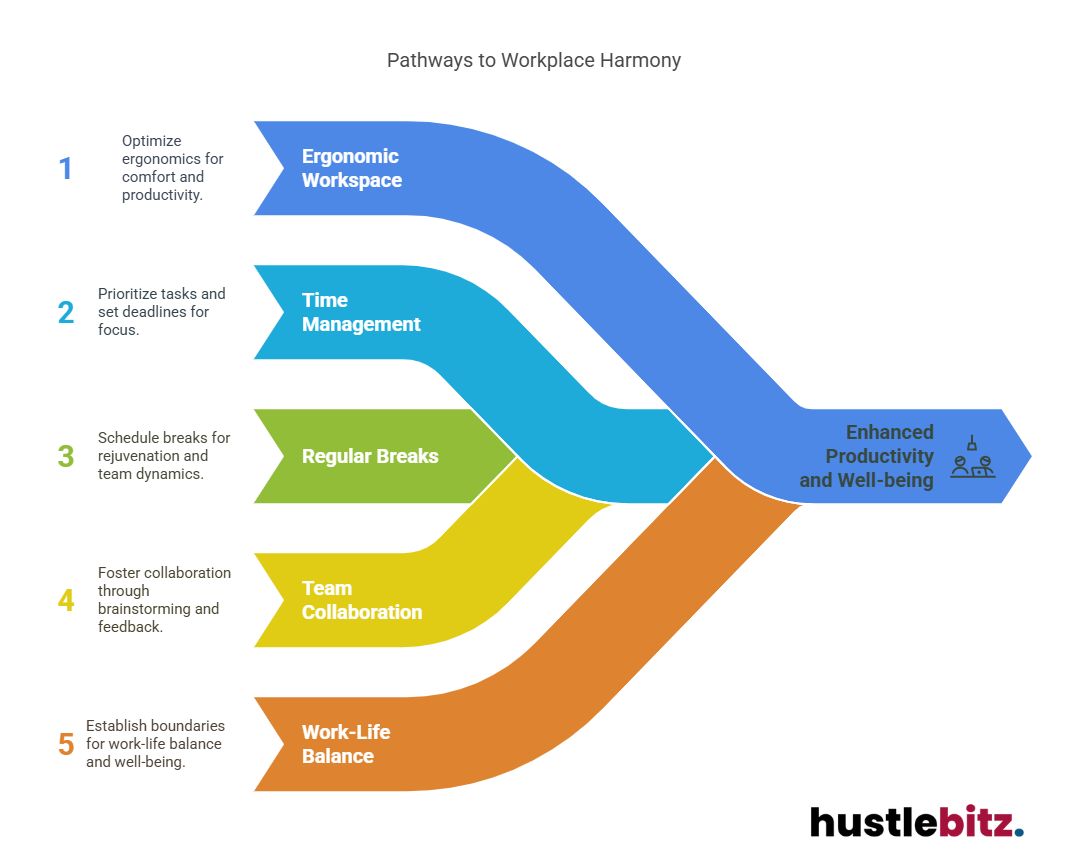To boost office productivity, focus on creating a productive workspace with ergonomic furniture and efficient lighting. Implement time management techniques, such as prioritizing tasks and setting deadlines, to enhance focus. Schedule regular breaks for physical activity and social interaction to rejuvenate energy levels. Encourage team collaboration through structured brainstorming and feedback sessions to leverage collective intelligence. Lastly, adapt flexible working hours to align with personal commitments, promoting satisfaction and efficiency. These strategies can significantly improve workplace dynamics. Further insights await to unlock even more effective approaches tailored to your team’s needs.
Key Takeaways
- Create a productive workspace by optimizing ergonomics, decluttering, and enhancing lighting to minimize distractions and improve comfort.
- Implement time management techniques like task prioritization, setting deadlines, and using timers to enhance focus and accountability.
- Schedule regular breaks for physical activity and social interaction to rejuvenate the mind and foster team dynamics.
- Encourage team collaboration through brainstorming sessions and feedback mechanisms to drive innovation and improve performance.
- Promote work-life balance by establishing healthy boundaries, which enhances employee well-being and reduces burnout.

Create a Productive Workspace
A productive workspace is essential for fostering focus and efficiency among employees, as it directly influences their ability to perform tasks effectively.
To optimize productivity, organizations should prioritize the implementation of ergonomic furniture, which not only enhances comfort but also reduces the risk of injury, allowing employees to concentrate on their work.
Additionally, maintaining decluttered spaces is crucial; a tidy environment minimizes distractions and promotes a sense of control.
Natural lighting should be maximized wherever possible, as it can significantly improve mood and alertness.
Incorporating personal touches, such as artwork or individual decor, can further enhance the workspace’s appeal, making employees feel more connected to their environment.
Noise control is also vital; utilizing sound-absorbing materials or designated zones for collaboration can create distraction-free areas that allow for deep focus.
Color psychology plays a pivotal role in workspace design. Selecting calming hues can foster creativity and reduce stress, while vibrant colors can energize and motivate teams.
Furthermore, tech integration is essential for streamlining workflows, ensuring that employees have the tools necessary for efficient task completion.
Designated zones within the office can facilitate various work styles, catering to both collaborative efforts and solitary tasks.
Additionally, the inclusion of plants not only improves air quality but also provides psychological benefits, creating a more inviting and productive atmosphere.
Implement Time Management Techniques

Effective time management techniques are essential for individuals and teams aiming to enhance productivity and achieve their goals efficiently. By implementing structured strategies, you can take control of your workload and maximize your output.
Start by prioritizing tasks based on urgency and importance. This helps in focusing on what truly matters. Set deadlines for each task to create a sense of urgency and accountability. Utilize timers to allocate specific periods for completing tasks, thereby encouraging sustained focus.
Limiting distractions is crucial; establish a dedicated workspace and use tools like website blockers to minimize interruptions. Planning daily can provide a clear roadmap of what needs to be accomplished. Review progress at the end of each day to assess what was achieved and where improvements can be made.
Delegating responsibilities allows team members to contribute effectively, freeing up your time for higher-priority tasks. To manage larger projects, break them into smaller, manageable components, making them less daunting and easier to track. Establishing routines creates a sense of normalcy and predictability, helping you to stay organized. Finally, tracking time spent on various tasks can provide insight into your efficiency, enabling you to make informed adjustments.
Here’s a summary of key time management techniques:
| Technique | Description |
| Prioritize Tasks | Focus on urgent and important tasks |
| Set Deadlines | Create urgency and accountability |
| Use Timers | Allocate specific time for tasks |
| Limit Distractions | Establish a dedicated and distraction-free workspace |
| Review Progress | Assess daily achievements and plan next steps |
Schedule Regular Breaks
Scheduling regular breaks throughout the workday is essential for maintaining sustained focus and enhancing overall productivity. These intentional pauses serve as mindful moments, allowing employees to recharge and regain their concentration.
In a fast-paced office environment, the importance of stepping away from screens cannot be overstated. Implementing a structured break schedule can serve as a powerful energy booster, helping to mitigate fatigue that often accompanies prolonged screen time.
Consider integrating the following break strategies into your daily routine:
- Outdoor walks: Stepping outside for fresh air not only invigorates the mind but also offers a chance for physical activity.
- Snack breaks: Healthy snacks can elevate energy levels and improve cognitive function, making them a crucial part of any break schedule.
- Creative breaks: Engaging in a short creative activity can stimulate new ideas and foster innovative thinking.
- Social interactions: Connecting with colleagues during breaks can enhance team dynamics and promote a positive work culture.
- Quiet zones: Designating areas for relaxation techniques or brief meditative practices can help employees unwind and reset.
Incorporating these elements into the workday not only promotes a digital detox but also enhances overall workplace well-being. By prioritizing regular breaks, professionals can cultivate an environment that supports productivity and encourages healthy work habits, ultimately leading to enhanced performance and satisfaction.
Encourage Team Collaboration

Fostering a culture of collaboration among team members can significantly enhance workplace productivity, building on the refreshed energy gained from regular breaks. By implementing structured team brainstorming sessions, organizations can harness the collective intelligence of their employees, leading to innovative solutions and improved outputs.
Utilizing collaborative tools is essential for facilitating communication and ensuring that everyone remains aligned on project goals. Incorporating regular feedback sessions into the workflow not only enhances individual performance but also strengthens team dynamics. These sessions provide an opportunity for idea sharing, allowing team members to voice their opinions and contribute to the decision-making process.
Encouraging participation in cross-functional projects can further enrich the team’s perspective and promote a holistic approach to problem-solving. To bolster teamwork, consider organizing team building activities that foster trust and camaraderie among employees. These activities can create a supportive environment where open communication thrives, making conflict resolution more effective when challenges arise.
Utilizing robust communication platforms can streamline discussions and enhance project management efficiency. Innovation workshops can also be pivotal, providing a structured setting for teams to explore new ideas and methodologies collaboratively.
Ultimately, encouraging team collaboration cultivates an atmosphere where everyone feels empowered to contribute, driving overall productivity and fostering a culture of continuous improvement. By prioritizing these collaborative strategies, organizations can unlock their team’s full potential, leading to sustained success and a competitive edge in the market.
Adapt Flexible Working Hours

Adapting flexible working hours can significantly enhance employee satisfaction and productivity by allowing individuals to align their work schedules with personal commitments and peak performance times. This approach fosters a culture of employee autonomy, encouraging workers to take ownership of their schedules while promoting a healthy work-life balance.
By implementing flexible schedules, organizations can leverage the productivity benefits of remote work and adaptive technology. Employees can choose when to work, maximizing their focus during peak hours. This fluidity not only improves task prioritization but also enhances communication flexibility among team members.
To facilitate this adaptation, consider the following strategies:
- Utilize productivity tools: Equip your team with software that supports remote collaboration and task management.
- Encourage regular check-ins: Foster an environment of open communication to ensure all team members are aligned and engaged.
- Set clear performance metrics: Focus on results rather than hours logged, reinforcing a results-oriented mindset.
- Promote healthy boundaries: Encourage employees to disconnect during non-working hours, enhancing overall well-being.
- Offer training on adaptive technology: Help your team utilize tools that can streamline their workflow and enhance productivity.
Final Thoughts
Boosting office productivity is achievable through a combination of thoughtful strategies that prioritize both employee well-being and organizational efficiency. By creating an optimized workspace, managing time effectively, scheduling regular breaks, fostering team collaboration, and embracing flexible working hours, businesses can cultivate a dynamic and productive environment. These practices not only enhance individual performance but also strengthen team dynamics, ultimately driving sustained success. As businesses continue to evolve, integrating these productivity techniques can ensure a more engaged, motivated, and efficient workforce.




